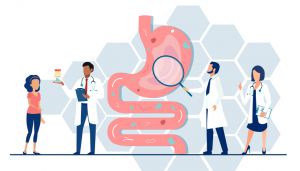
Microbial medicine has significantly evolved in recent years, and we now know nourishing the microbiome is a potential treatment option and prevention strategy for many health concerns. Microbial communities are found in many areas within the human body, including the gut, skin, lungs, sinuses, mouth, and urinary tract.1 Each human harbors between 10 and 100 trillion micro-organisms in their microbiomes, and the vast majority of them are in the gut.2 The gut microbiome and its metabolites, in particular, play a fundamental role in many bodily functions, including nutrient production, nutrient absorption, immune system regulation, and the defense against infections, including viral infections.1
The metabolites produced by microbiomes directly influence immune cell development and susceptibility to infectious diseases. These compounds affect immune function and cellular metabolism at both local and distant sites. Specifically, the bioactive metabolites from microbiomes can boost the activity of T-lymphocytes, natural killer cells, macrophages, neutrophils, and other immune cells to support a healthy immune response systemically.3 Several studies confirm that signals from the microbiomes can enhance optimal antiviral immunity.2
Research performed during the COVID-19 pandemic demonstrates that decreased richness and diversity of the gut microbiome are associated with immune dysfunction, prolonged diarrhea, delayed viral clearance, and increased mortality due to severe lung infection. Mounting evidence also suggests that treatment with broad-spectrum antibiotics, which can kill the beneficial bacteria in microbiomes, will cause a low or impaired immune response against viral infections in general, including respiratory syncytial virus (RSV) and influenza viruses.1
Emerging metabolite-centered research continues to highlight how an unhealthy microbiome can also contribute to the development of many other diseases, including metabolic syndrome, obesity, diabetes, heart disease, and cancer.1 The powerful metabolites produced by the organisms in our microbiomes are called postbiotics.

What are Postbiotics?
To understand the concept of postbiotics, a brief review of probiotics and prebiotics is helpful. Probiotics are defined as “live microorganisms which, when administered in adequate amounts, confer a health benefit on the host.” To produce postbiotics, the living probiotics must digest and transform prebiotics, including dietary fiber and other substances naturally found in food, into postbiotics.4,5
A postbiotic is currently defined as a “preparation of inanimate microorganisms and/or their components that confers a health benefit on the host.” So, postbiotic preparations can contain inactivated bacteria and/or the compounds secreted by these bacteria.3 Postbiotic substances include enzymes, bioactive peptides, short-chain fatty acids (SCFAs), antimicrobial peptides, polysaccharides, cell surface proteins, vitamins, plasmalogens, organic acids, bacteriocins, inanimate (dead) bacteria, and other compounds.4
The probiotics in the gut microbiome may or may not produce the optimal beneficial postbiotic compounds in sufficient quantities, especially when the consumption of prebiotics is not adequate. Since the production of numerous beneficial postbiotic compounds is not guaranteed, even with probiotic and prebiotic supplementation, postbiotics are now produced in controlled environments outside the gut and available as supplements and pharmaceutical prescriptions.
Lactic acid bacteria (LAB) are probiotics that have been evaluated and recommended for the prevention and treatment of viral infections for years as probiotic supplements. According to the latest research, the postbiotics produced by LAB are potential candidates for the therapeutic control of several viruses in humans. The aquaculture and poultry industries already use LAB probiotics and their postbiotics as antiviral agents. Evidence supporting the use of postbiotics produced by LAB as antiviral agents in humans continues to accumulate.6,7
Two classes of postbiotics that offer antiviral benefits are bacteriocins and short-chain fatty acids (SCFAs).
Bacteriocins – Antiviral Postbiotics
According to the results of years of research, the postbiotics known as bacteriocins offer significant antiviral benefits against numerous viruses, including the measles virus, influenza viruses, herpes simplex virus 1 (HSV-1), herpes simplex virus 2 (HSV-2), enteroviruses, such as polioviruses, Coxsackieviruses, and echoviruses, HIV-1, coronaviruses, and viruses that affect animals.1,6-10
Many bacteriocins have been extensively studied, and some have been commercially developed due to their ability to preserve food. Most bacteriocins are colorless, odorless, tasteless, and stable at high and low temperatures, which makes them highly attractive for food preservation and many other applications.11
The bacteriocin known as nisin is produced by Lactococcus lactis and is the most extensively studied and commercially utilized of all the bacteriocins.6 Both the FDA and EFSA authorities have approved the safety profile of nisin.11 Other bacteriocins produced by strains of Lactobacillus spp. and Lactococcus spp. also exhibit antiviral activity. Even the bacteriocins naturally present in traditional fermented food products have demonstrated moderate antiviral activity against various viruses, including herpesviruses.6
Plantaricins are bacteriocins produced by the probiotic Lactiplantibacillus plantarum. Research suggests plantaricins offer antiviral activity against echoviruses, Coxsackieviruses, rotaviruses, and coronaviruses, including SARS-CoV-2.9,10
Based on the available evidence to date, most bacteriocins do not appear to kill viruses directly; rather, they interfere with viral replication by inhibiting certain enzymes that are critical for the virus life cycle.6 They also interfere with viral replication by inducing the aggregation of viral particles and blocking the viral particles from entering cells. The bacteriocins bind to and protect cells.12 The inhibition of viral replication reduces the viral load, which can reduce the severity of an infection.13
Bacteriocins also beneficially interact with the mucosal surfaces and the epithelial cells that line the gastrointestinal (GI) and respiratory tracts, which are the main routes of viral entry into the body. Mucosal surfaces could be targeted with antiviral postbiotic nasal sprays and other innovative products in the future. Bacteriocins synthesized by the probiotics that live along the mucosal surfaces can enter the bloodstream to reach infected organs, such as the lungs, and provide health benefits throughout the body.10,14,15

Short-Chain Fatty Acids – Antiviral Postbiotics
Short-chain fatty acids (SCFAs) are probably the most investigated bacterial metabolites. SCFAs include butyrate, propionate, and acetate. Research shows SCFAs regulate inflammation and modulate the immune response against pathogens, including viruses. Butyrate is considered an immunomodulatory compound that is also an essential energy source for the cells that line mucosal surfaces. The mucosal surfaces are the first line of defense against infections. In the gut, butyrate provides the energy needed for colonic cells to multiply and maintain healthy gut barrier function, which may prevent leaky gut syndrome and viral infections.15,16
Research confirms patients with abundant butyrate-producing bacteria are less likely to develop viral respiratory infections. Correlation analysis reveals butyrate levels negatively correlate with viral loads during influenza infection. So, the higher the butyrate level, the lower the viral load.12 According to the evidence, SCFAs support the immune response during lung infections by amplifying the IL-10 level in the lungs, boosting lymphocyte antigen 6C, increasing monocytes in the lungs during influenza infections, and decreasing the influx of neutrophils, which can damage delicate lung tissue.15
Animal studies also suggest SCFAs offer robust antiviral properties. In one animal study, the mice fed a diet high in fermentable fiber or supplemented with SCFAs had decreased lung damage, a lower viral load, and an increased chance of survival during influenza and RSV infections.17

How Can Postbiotic Levels Be Increased?
Fermented Foods
Fermented foods, such as yogurt, kimchi, tempeh, sauerkraut, kefir, natto, and miso, offer a dynamic combination of prebiotics, probiotics, and postbiotics.18 Unfortunately, experimental studies and clinical trials have not yet definitively confirmed the significant effect of fermented foods in preventing and treating viral diseases because minimal research has been performed.19
The available research does show kefir and kefir derivatives inhibit viral activity by modulating immune-system responses and disrupting viral activity. Enhancing macrophage production and inhibiting the activity of pro-inflammatory cytokines such as IL-1β, TNF-α, and IL-6 are some of the ways kefir modulates the immune system.19 And in a recent animal study, the administration of a fermented milk product to animals with rotavirus significantly reduced the incidence and severity of diarrhea. The authors of the study also noted the broad spectrum of postbiotics present in the fermented food enhanced the expression of Toll-like receptors (TLRs) to support a healthy immune response.20
So, consider recommending fermented foods to increase the levels of healthy postbiotics in your patients.

Cell-Free Supernatants
Full-spectrum postbiotic blends are available as “cell-free supernatants,” which are produced by separating the surrounding postbiotic liquid from the bacterial cultures. Supernatants produced by various LAB offer anti-inflammatory, microbiome-supportive, antioxidant, anti-cancer, gut barrier-supportive, antibacterial, antiviral, and other benefits.21 At least one wholesome, nourishing, concentrated, and broad-spectrum postbiotic supernatant is available as an over-the-counter supplement.*
Bacterial Lysate
Bacterial lysates (BLs) are available by prescription and are essentially dead and degraded pathogenic bacteria. BLs are usually in tablet form that can be chewed or swallowed. BLs have been used safely for years in pediatric, internal medicine, and infectious disease practices. BLs can be prescribed to prevent both viral and bacterial respiratory infections due to the activity of the “gut-lung axis,” which is a communication between the gut microbiome and the respiratory immune system. Several mechanistic studies confirm that orally administered BLs stimulate the dendritic cells (DCs) and activate the T and B lymphocytes in the gut, which then migrate to the respiratory tract. BLs stimulate the innate immune system, increase the secretion of protective IgA antibodies, and act like vaccines.
A meta-analysis published in 2018 assessed the effects of BLs on more than 4800 children. The authors of the analysis concluded the children who received the BLs had a significantly lower incidence of respiratory tract infections. And a 2020 systematic review demonstrated that BLs are effective in reducing wheezing episodes and the frequency of asthma exacerbations in children.21

Probiotics and Prebiotics
Supplemental probiotics and prebiotics could increase the levels of postbiotics produced by the gut microbiome. Prebiotics, including dietary fiber, undergo bacterial fermentation by the probiotics in the gut, which turn them into the metabolic end products known as postbiotics. The primary postbiotics produced via the bacterial fermentation of prebiotics are SCFAs, namely acetate, propionate, and butyrate. The type of prebiotic consumed does affect the amount of SCFAs produced, according to research. Fructooligosaccharides (FOS), galactooligosaccharides (GOS), isomaltooligosaccharides (IOS), and xylooligosaccharides (XOS) are examples of prebiotics that offer high solubility and a robust rate of fermentation by probiotics. Resistant starch, inulin, β-glucan, and soluble arabinoxylan are prebiotics that are partially fermented in the gut. Granulated starch, insoluble arabinoxylan, bacterial cellulose, and bran fiber have low solubility and, therefore, a slower, less reliable fermentation rate.22
Probiotic and prebiotic blends are available as supplements.

The Future
Postbiotics are now being developed as new therapeutic strategies for many diseases since they offer natural bioavailability, safety at high concentrations, easy administration, and tissue tolerability.1 The results obtained from various studies indicate the essential and supportive role of bacteriocins, SCFAs, and other postbiotic compounds in managing viral diseases. Overall, research shows postbiotics offer antiviral activity against the measles virus, noroviruses, enteroviruses, including Coxsackie viruses, polioviruses, and echoviruses, Hepatitis A Virus, influenza viruses, HSV-1, HSV-2, rotaviruses, HIV-1, coronaviruses, and several viruses that affect animals.1,3,6-10
So, increasing daily intakes of probiotics, prebiotics, and postbiotics could be an effective antiviral strategy backed up by modern research. Postbiotics, in particular, might be an exceptionally powerful addition to the natural therapeutic arsenal for the prevention and treatment of respiratory viral infections.6 Furthermore, the continued study of postbiotics could identify new antiviral molecules in the future.23
To assess the health of the gut microbiome and the immune system, including levels of protective secretory IgA (sIgA) antibodies, consider ordering the Expanded GI Health Panel™ with GP3x and Calprotectin. An overview of our GI Health Panels is available HERE.
To order test kits, click here. As a reminder, DiagnosTechs will drop ship test kits directly to your patients. You may select this option at the top of the order form.
Please visit our Provider Tools page for more information about test result interpretation, treatment options, and more.
References:
- Gebrayel P, Nicco C, Al Khodor S, et al. Microbiota medicine: towards clinical revolution. J Transl Med. 2022;20(1):111. doi:10.1186/s12967-022-03296-9
- Ailioaie LM, Litscher G. Probiotics, Photobiomodulation, and Disease Management: Controversies and Challenges. Int J Mol Sci. 2021;22(9):4942. doi:10.3390/ijms22094942
- Varsha KK, Narisetty V, Brar KK, et al. Bioactive metabolites in functional and fermented foods and their role as immunity booster and anti-viral innate mechanisms [published online ahead of print, 2022 Jun 24]. J Food Sci Technol. 2022;1-10. doi:10.1007/s13197-022-05528-8
- Firetag L. The Gut Microbiome and Asthma. InterPlexus. https://interplexus.com/blogs/news/the-gut-microbiome-and-asthma. Published May 5, 2022. Accessed September 14, 2022.
- Gibson GR, Hutkins R, Sanders ME, et al. Expert consensus document: The International Scientific Association for Probiotics and Prebiotics (ISAPP) consensus statement on the definition and scope of prebiotics. Nat Rev Gastroenterol Hepatol. 2017;14(8):491-502. doi:10.1038/nrgastro.2017.75
- Todorov SD, Tagg JR, Ivanova IV. Could Probiotics and Postbiotics Function as “Silver Bullet” in the Post-COVID-19 Era? Probiotics Antimicrob Proteins. 2021;13(6):1499-1507. doi:10.1007/s12602-021-09833-0
- Erol I, Kotil SE, Fidan O, et al. In Silico Analysis of Bacteriocins from Lactic Acid Bacteria Against SARS-CoV-2 [published online ahead of print, 2021 Nov 27]. Probiotics Antimicrob Proteins. 2021;1-13. doi:10.1007/s12602-021-09879-0
- Anwar F, Altayb HN, Al-Abbasi FA, et al. Antiviral effects of probiotic metabolites on COVID-19. J Biomol Struct Dyn. 2021;39(11):4175-4184. doi:10.1080/07391102.2020.1775123
- Rocchetti MT, Russo P, Capozzi V, et al. Bioprospecting Antimicrobials from Lactiplantibacillus plantarum: Key Factors Underlying Its Probiotic Action. Int J Mol Sci. 2021;22(21):12076. doi:10.3390/ijms222112076
- Ozma MA, Abbasi A, Akrami S, et al. Postbiotics as the key mediators of the gut microbiota-host interactions. Infez Med. 2022;30(2):180-193. doi:10.53854/liim-3002-3
- Tiwari SK, Dicks LMT, Popov IV, et al. Probiotics at War Against Viruses: What Is Missing From the Picture? Front Microbiol. 2020;11:1877. doi:10.3389/fmicb.2020.01877
- Wang Y, Moon A, Huang J, et al. Antiviral Effects and Underlying Mechanisms of Probiotics as Promising Antivirals. Front Cell Infect Microbiol. 2022;12:928050. doi:10.3389/fcimb.2022.928050
- Granados A, Peci A, McGeer A, et al. Influenza and rhinovirus viral load and disease severity in upper respiratory tract infections. J Clin Virol. 2017;86:14-19. doi:10.1016/j.jcv.2016.11.008
- Xavier-Santos D, Padilha M, Fabiano GA, et al. Evidences and perspectives of the use of probiotics, prebiotics, synbiotics, and postbiotics as adjuvants for prevention and treatment of COVID-19: A bibliometric analysis and systematic review [published correction appears in Trends Food Sci Technol. 2022 Mar;121:156-160]. Trends Food Sci Technol. 2022;120:174-192. doi:10.1016/j.tifs.2021.12.033
- Gautier T, David-Le Gall S, Sweidan A, et al. Next-Generation Probiotics and Their Metabolites in COVID-19. Microorganisms. 2021;9(5):941. doi:10.3390/microorganisms9050941
- Firetag L. Postbiotics and intestinal permeability (leaky gut syndrome). InterPlexus. https://interplexus.com/blogs/news/postbiotics-and-intestinal-permeability-leaky-gut-syndrome. Published August 5, 2022. Accessed September 16, 2022.
- Ji JJ, Sun QM, Nie DY, et al. Probiotics protect against RSV infection by modulating the microbiota-alveolar-macrophage axis. Acta Pharmacol Sin. 2021;42(10):1630-1641. doi:10.1038/s41401-020-00573-5
- Dimidi E, Cox SR, Rossi M, et al. Fermented Foods: Definitions and Characteristics, Impact on the Gut Microbiota and Effects on Gastrointestinal Health and Disease. Nutrients. 2019;11(8):1806. doi:10.3390/nu11081806
- Montazeri-Najafabady N, Kazemi K, Gholami A. Recent advances in antiviral effects of probiotics: potential mechanism study in prevention and treatment of SARS-CoV-2 [published online ahead of print, 2022 Jun 28]. Biologia (Bratisl). 2022;1-18. doi:10.1007/s11756-022-01147-y
- Morales-Ferré C, Azagra-Boronat I, Massot-Cladera M, et al. Preventive Effect of a Postbiotic and Prebiotic Mixture in a Rat Model of Early Life Rotavirus Induced-Diarrhea. Nutrients. 2022;14(6):1163. doi:10.3390/nu14061163
- Scarpellini E, Rinninella E, Basilico M, et al. From Pre- and Probiotics to Post-Biotics: A Narrative Review. Int J Environ Res Public Health. 2021;19(1):37. doi:10.3390/ijerph19010037
- Ashaolu TJ, Ashaolu JO, Adeyeye SAO. Fermentation of prebiotics by human colonic microbiota in vitro and short-chain fatty acids production: a critical review. J Appl Microbiol. 2021;130(3):677-687. doi:10.1111/jam.14843
- Piscotta FJ, Hoffmann HH, Choi YJ, et al. Metabolites with SARS-CoV-2 Inhibitory Activity Identified from Human Microbiome Commensals. mSphere. 2021;6(6):e0071121. doi:10.1128/mSphere.00711-21


